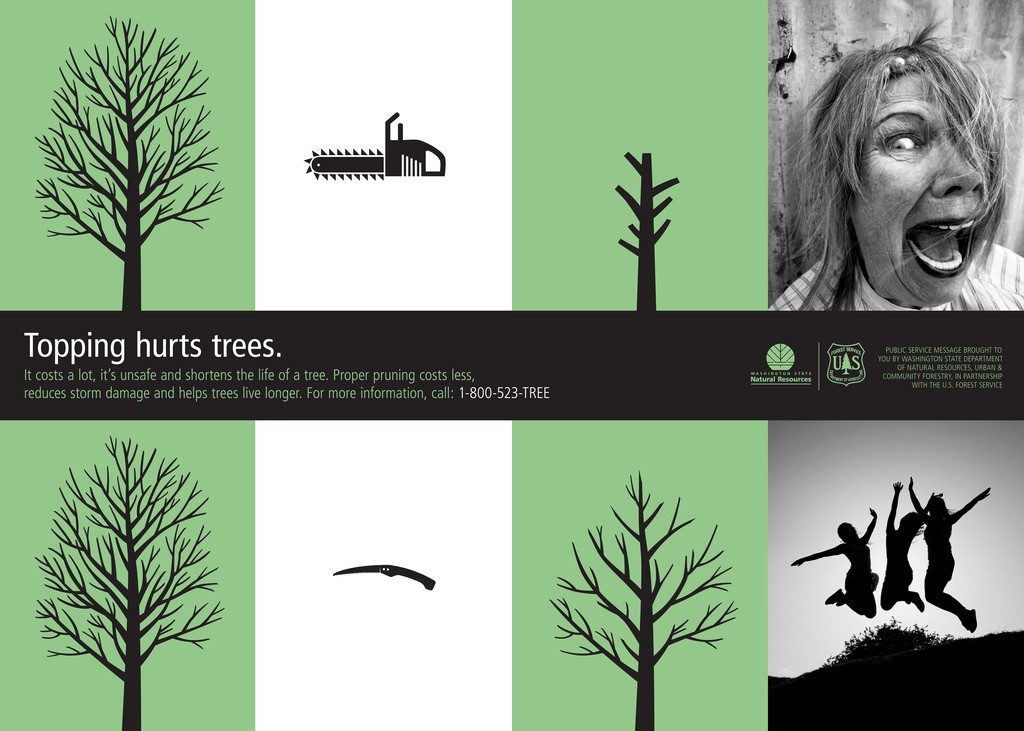Tree-topping: If you need a place to hang your hat and (law)suit

Poster: Luis Prado, Washington Dept. of Natural Resources
Tree topping is a subject I can really get worked up about. It’s unprofessional, unsightly, outrageous, unethical, dangerous, and I even suspect it leads to more frequent rainy weekends and bad-hair days. It’s unthinkable, horrible, bad and yucko! That should be pretty clear—any questions? Oh, exactly what is tree topping? Hang on. Mmmph—there, that’s better. Had to wipe the foam off my mouth.
Tree topping is the removal of limbs and or/ trunks to an arbitrary length, leaving stubs. Variably known as heading, hat-racking or tipping, it is denounced by the Tree Care Industry of America, The International Society of Arboriculture and other professional tree-care organizations.
Topping is not to be confused with pollarding, a practice dating to feudal times when peasants could be put to death for cutting down the king’s trees, but were allowed to clip each year’s twig extension back to a callus “ball” for use as fuel and fodder. Pollarding does not work on all species, and to be successful must be started when a tree is relatively young and continued annually.
Back to topping. It shortens a tree, but doesn’t alter the tree’s DNA which instructs it to grow to its species potential. After the natural branch structure is destroyed by topping, new growth erupts from the bark. These shoots, called epicormic sprouts, will become major branches. Unfortunately, they are always poorly attached to the parent wood.
Because the tree is in a “hurry” to re-gain its genetically mandated height, the new branches grow faster than usual. You know haste makes waste, and as a tree cranks out these replacement limbs, it “forgets” to add much lignin, stuff that helps make branches strong. So now we have branches weaker than the originals, badly hitched up to the trunk or major branch wood.
But that is not all—there are two more things. Thing One is decay, which sets in at each topping wound. Our flimsy new branches soon find themselves attached to a rotting stub. It may take thirty years or it may happen in fewer than five, but every topping cut grows a killer limb. Of the precious few certainties in life, three of them are “death,” “taxes,” and “tree topping creates hazards.”
Thing Two is the tree’s budget. A hat-racked tree has to take “money out of the bank”–starch out of storage–to replace leaf-bearing wood at a time when much of its bank account, the starch stored in woody tissues, has been stolen and run through a chipper.
Trees need reserves to make defensive chemicals that protect against pests and decay, to expand root systems, and produce each year’s leaves. A topped tree is weaker and is far more vulnerable to decay, disease, and insects than it had been before its “treatment.” If a short tree is desired, a short-maturing species should be planted.
It may sound like I’m backpedaling, but there is a practice called “crown reduction pruning” which can slightly reduce the height of hardwood trees while maintaining their natural architecture. Crown reduction takes a good deal of training to do properly. It can only reduce a tree’s height 20-25 percent, and has to be repeated every three-five years as deemed prudent by an experienced arborist. Another practice, called “crown thinning,” addresses fears about a tree blowing over. This is the judicious pruning of branches evenly throughout the canopy to reduce wind resistance. A maximum of 20 percent of live branches may be taken. Again, this takes a great deal more skill than topping.
The International Society of Arboriculture, a research and education association of tree care professionals, advises the public that a tree company which advertises topping should not be hired for any work. Period. Like, don’t let them set foot on your property. A company willing to top trees is by definition less than professional, and less likely to understand other elements of tree care, including basic safety procedures.
Tree topping is acceptable, however, for all who enjoy forty-foot hat racks and liability lawsuits. Now are there any questions?
Paul Hetzler is a horticulture and natural resources educator with Cornell Cooperative Extension of St. Lawrence County.
Tags: forestry, tree care, tree-topping








Don’t hold back! Tell us what you really think!
Yeah, I find it hard to to just lay it out honestly. Sorry to beat around the, um, bush so much.
Great explanation! I really appreciated your taking the time and trouble to share so thoroughly! Excellent ! Keep up the good work!